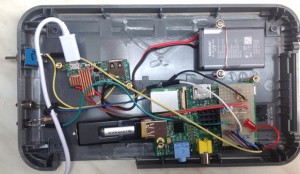Raspberry Media Server
Als Entertainment-System für mein Auto setzte ich ein Raspberry mit zwei Tablets ein.
Dies funktioniert über WLAN, so dass keine Kabel notwendig sind.
Die Konfiguration der Wifi-Verbindung wird hier sehr gut beschrieben:
DLNA wird prinzipiell von allen Playern auf allen Betriebssystemen unterstützt. Eine einfache und schöne Anleitung ist hier zu finden:
http://www.gehaxelt.in/blog/raspberrypi-minidlna-mediaserver/
Inder Konfigurationsdatei für minidlna muss man das WLAN interface einbinden: network_interface=wlan0
/etc/minidlna.conf
[codesyntax lang=”text”]
# media_dir=/var/lib/minidlna
media_dir=A,/media/usb-pearl/Musik
media_dir=P,/media/usb-pearl/Bilder
media_dir=V,/media/usb-pearl/Videos
# Path to the directory that should hold the database and album art cache.
db_dir=/var/lib/minidlna
# Path to the directory that should hold the log file.
log_dir=/var/log
# Minimum level of importance of messages to be logged.
# Must be one of "off", "fatal", "error", "warn", "info" or "debug".
# "off" turns of logging entirely, "fatal" is the highest level of importance
# and "debug" the lowest.
log_level=error
# Use a different container as the root of the directory tree presented to
# clients. The possible values are:
# * "." - standard container
# * "B" - "Browse Directory"
# * "M" - "Music"
# * "P" - "Pictures"
# * "V" - "Video"
# if you specify "B" and client device is audio-only then "Music/Folders" will be used as root
#root_container=.
# Network interface(s) to bind to (e.g. eth0), comma delimited.
network_interface=wlan0
# IPv4 address to listen on (e.g. 192.0.2.1).
#listening_ip=
# Port number for HTTP traffic (descriptions, SOAP, media transfer).
port=8200
# URL presented to clients.
# The default is the IP address of the server on port 80.
#presentation_url=http://example.com:80
# Name that the DLNA server presents to clients.
friendly_name=XC60 Media Server
# Serial number the server reports to clients.
serial=12345678
# Model name the server reports to clients.
model_name=XC60 Media Connect compatible (MiniDLNA)
# Model number the server reports to clients.
model_number=1
# Automatic discovery of new files in the media_dir directory.
inotify=yes
# List of file names to look for when searching for album art. Names should be
# delimited with a forward slash ("/").
album_art_names=Cover.jpg/cover.jpg/AlbumArtSmall.jpg/albumartsmall.jpg/AlbumArt.jpg/albumart.jp$
# Strictly adhere to DLNA standards.
# This allows server-side downscaling of very large JPEG images, which may
# decrease JPEG serving performance on (at least) Sony DLNA products.
#strict_dlna=no
# Support for streaming .jpg and .mp3 files to a TiVo supporting HMO.
enable_tivo=no
# Notify interval, in seconds.
notify_interval=300
# Path to the MiniSSDPd socket, for MiniSSDPd support.
#minissdpdsocket=/run/minissdpd.sock
[/codesyntax]
Den Server habe ich mit der USV zusammen in ein Gehäuse einer alten Festplatte eingebaut:



